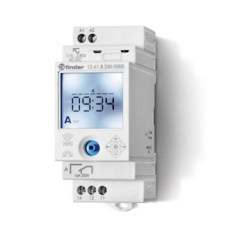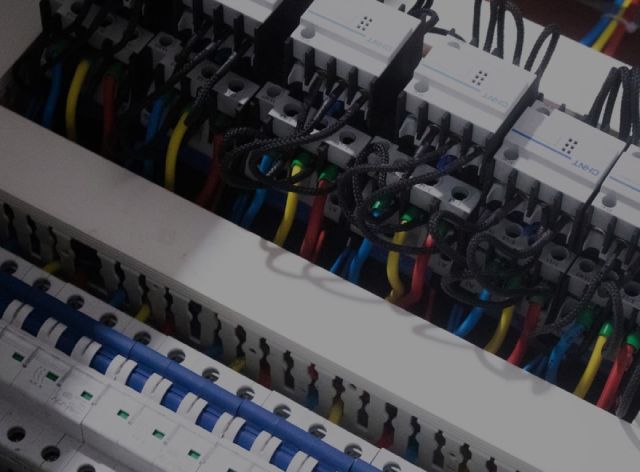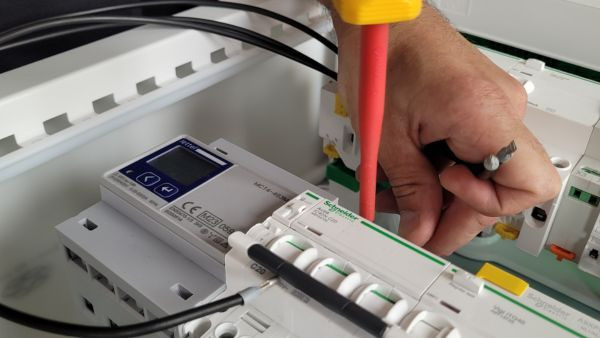What is a modular time switch?
Modular time switches, also known as programmable time switches, timer switches for distribution boards, or simply DIN rail time switches, are programmable relays that control the power supply of an electrical circuit.
They are installed directly on a DIN rail inside an electrical distribution board, alongside circuit breakers and contactors.
These devices are widely used in:
- Residential applications: garden irrigation, switching off internet routers at night, heating control.
- Commercial buildings: managing outdoor lighting, advertising signs, ventilation systems.
- Industrial facilities: controlling pumps, motors, HVAC systems, or safety devices.
Their primary function is to schedule repetitive ON/OFF events automatically, improving energy efficiency and user comfort.
Types of modular time switches
Several types of programmable timer switches are available, depending on the level of precision and the application.
1. Digital modular time switches
- Equipped with an LCD display and programming buttons.
- Offer minute-level precision.
- Available as daily, weekly, or annual timers.
- Some models allow smartphone programming and NFC transfer.
- Example: a weekly programmable timer that repeats schedules week after week.
2. Analog modular time switches
- Operate with rotating dials and mechanical segments.
- Programming intervals typically range from 15 to 30 minutes.
- Simple to use, ideal for daily repetitive cycles such as lighting control.
3. Astronomical time switches
- Automatically adjust switching times according to sunrise and sunset.
- Perfect for outdoor lighting, signage, and public lighting systems.
- Should not be confused with photocell switches (twilight switches), which react to actual light levels and may switch on during a storm.
4. Single-pole or double-pole versions
- 1-pole (single-circuit): controls one electrical circuit.
- 2-pole (double-circuit): controls two independent circuits.
Benefits of modular time switches
- Energy savings: reduce unnecessary electricity consumption.
- Convenience: automate equipment without manual intervention.
- Safety: ensure lighting in stairwells, garages, or outdoor pathways.
- Flexibility: suitable for residential, commercial, and industrial use.
- Extended equipment life: avoid continuous operation and reduce wear.
How does a modular time switch work?
A DIN rail time switch operates as a programmable relay inside the electrical panel.
- When installed on a DIN rail, it supplies or cuts off power to a circuit based on programmed schedules.
- Digital timers provide minute-level precision; analog timers operate in fixed intervals.
- Astronomical timers automatically adjust daily schedules to the solar cycle.
Examples of use:
- Residential: run a water heater only during off-peak tariff hours.
- Commercial: switch off a parking lot lighting system at midnight.
- Industrial: cycle pumps or fans during working hours only.
Key selection criteria
When selecting a programmable modular time switch, consider the following points:
1. Type of timer
- Analog: basic, cost-effective, less precise.
- Digital: precise and flexible, with weekly or annual programs.
- Astronomical: perfect for outdoor lighting.
2. Programming cycle
- Daily: same schedule every day.
- Weekly: different schedules for each day of the week.
- Annual: long-term planning with holidays or seasons.
- Astronomical: based on sunrise and sunset times.
3. Load capacity
- Timer switches usually control circuits rated between 5A and 16A (single-phase).
- For higher currents, use a power contactor controlled by the timer switch.
4. Number of circuits
- 1-pole models: for a single circuit.
- 2-pole models: for two independent loads.
5. Additional features
- Astronomical function for daylight-based scheduling.
- Smartphone programming via NFC or Bluetooth.
- Battery backup to keep settings during power outages.
6. Ease of use
- Analog: quick setup with mechanical pins.
- Digital: greater flexibility but programming may take more time.
7. Environment and protection
- For outdoor or harsh environments, choose models with a high IP rating (IP55, IP65).
- Ensure resistance to UV exposure and mechanical stress.
Example applications
- Residential: a 200L water heater programmed to run only during off-peak hours (10 PM – 6 AM).
- Commercial: an astronomical time switch controlling a shop sign, automatically adjusting for seasonal daylight.
- Industrial: ventilation fans in a warehouse programmed to run during working hours only.
Installation of a modular time switch
- Mounting: installed on a DIN rail inside the distribution board.
- Wiring: connect according to the manufacturer’s diagram.
- Programming:
- Analog: by mechanical pins or segments.
- Digital: via LCD menus and buttons.
- Verification: check compatibility with the main circuit breaker and load requirements.
Optim-Elec’s range of modular time switches
Finder
- Smart digital time switches with NFC programming via smartphone.
- Support for astronomical programs and geo-location based settings.
Theben
- Wide range of digital and analog time switches.
- Daily, weekly, annual, and astronomical programs.
- High precision and reliability.
Schneider
- Robust, professional-grade timer switches.
- Designed for industrial and commercial installations.
Lettel
- Compact programmable timers, daily or weekly.
- Available with 1 or 2 changeover contacts.
- Affordable and easy to use.
The Optim-Elec range
The Optim-Elec range
Frequently Asked Questions
Read More
Read More
Read More
Read More
Read More









